Top News
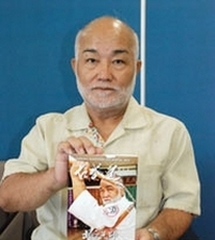
October 11, 2011 Ryukyu Shimpo
Masahiro Nakamoto, the president of the Okinawa Traditional Kobudo Preservation Society (Bunbukan), has published the Kobudo-Buseisenshi in English under the title Okinawa Traditional Old Martial Arts – The First Hanshi 10th Dan Okinawa Kobudo. Released to coincide with the 5th Worldwide Uchinanchu Festival, the book introduces the beginning of traditional karate suidi inherited from the Ryukyu Dynasty era, as well as giving information on the masters who created the foundation of karate in modern and contemporary times, and weapons used in kobudo such as the bou (6-foot staff) and the sai (trident).
Nakamoto said, “By publishing this English version, I would like to introduce our culture to second and third generation Okinawans living overseas who do not understand Japanese. I think that being aware of the legacy of traditional karate and kobudo will help give them pride and confidence about being Okinawan.”
The book was written by Nakamoto in 2009 and was translated into English by Miguel Da Luz, who is from France and has studied traditional karate in Okinawa. In the English version, Nakamoto includes a photograph of his students training in front of a traditional Okinawan tomb.
He said, “It is said that karate was kept secret in the Ryukyu era in attempt to keep it undiscovered by Satsuma Domain. These days of course, Okinawan karate attracts attention all around the world, but when we are practicing it, it is important not to forget its origin.” The book sells for 3150 yen in bookstores in Okinawa.
(English Translation by T&CT, Shinako Oyakawa and Mark Ealey)
Go To Japanese
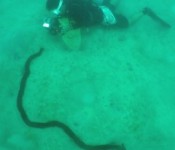
October 9, 2011 Ryukyu Shimpo
On August 21, an example of the world’s largest synaptid sea cucumber, the kurenaiooikarinamako, was found in Funaura Bay in Iriomote Island, Taketomi Town. Toru Naruse, an assistant professor of the Tropical Biosphere Research Center University of the Ryukyus, and three others found it. Iriomote is the fifth habitat for this type of sea cucumber to be found in the world after Oura Bay, Nago Bay, Kakeroma Island in Amami, Kagoshima Prefecture, and Palau.
The length of the sea cucumber found by Naruse is 362 centimeters. He said that it had shellfish and copepod parasites attached to it, and that because this species of shellfish is also found around Iriomote Island, there should be more sea cucumber in that area.
Given that sea cucumbers prefer quite a unique environment in which sea mud and sand are reasonably well-mixed together, Naruse said, “We found the specific environment suited to sea cucumbers in Funaura Bay. This may be why other rare creatures are also found in that bay.” He will continue his biological survey.
After being photographed and examined closely, the sea cucumber will be put in the University museum – Fukujukan – as a display specimen.
(English translation by T&CT, Shinako Oyakawa and Mark Ealey)
Go To Japanese

October 11, 2011 Kiyoshi Ujiie of the Ryukyu Shimpo
A social-networking site that was designed to create connections among Uchinanchu around the world and is run by a third-generation Okinawan from Hawaii, Daniel Hiroki Chinen (44 years old), is rapidly growing in popularity. The site maintains active dialogues among its users who exchange information and hold study sessions on Okinawan culture. Already more than 1000 people have joined.
In the past, while Chinen was aware of his Okinawan descent, he had no particular interest in Okinawa. After he finished graduate school in mainland United States he happened to meet some Okinawans in Hawaii. Their encouragement saw him participate in the 4th Worldwide Uchinanchu Festival in 2006, and impressed by the participants, who clearly enjoyed the music and the atmosphere, he came to understand the spirit of ichariba chode, (which in English means “once we meet, we are all brothers and sisters.”)
Thinking that meeting once every five years meeting is too infrequent, Chinen started creating a website as a tool to create networks. In 2007, Chinen moved to Okinawa to study Okinawan history. He currently studies at the University of the Ryukyus, and also strives to improve his ability on the sanshin and at karate.
Chinen says that he is concerned that “College students whom I’ve met at the university seem to be less conscious of having an identity as an Okinawan.” These days students who cannot perform eisa or do any karate are not uncommon. On his website, Chinen strives to contribute to the preservation and revitalization of Okinawan culture. At the 5th Worldwide Uchinanchu Festival, Chinen will attend an exchange event in Sashiki, Nanjo City, which is the birthplace of his grandfather. “I want to feel ichariba chode again,” said Chinen, excited to be participating in the Festival for the second time.
(English Translation by T&CT, Megumi Chibana and Mark Ealey)
Go To Japanese
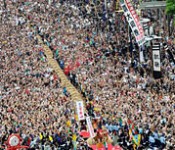
October 10, 2011 Ryukyu Shimpo
In the afternoon of October 9, the 41st Naha Ozunahiki or Naha Giant Tug-of-War, which was recorded in the Guinness Book of World Records as the world’s largest rope in 1997, was held at Kumoji intersection on Route 58 in Naha City. The event was organized by the Office of the Conservation Society of the Naha Giant Tug-of-War.
The organizers announced that a total of 275000 people came to the event. The people by the rope pulled with all their might, calling out “haa-iya” amid the white-hot atmosphere of the afternoon.
Many of the people of Okinawan decent who came to Okinawa to participate in the 5th Worldwide Uchinanchu Festival which is due to start on October 13 also participated in the Naha Giant Tug-of-War. They each pulled the rope with their own particular motivation in mind, but all enjoyed what is without a doubt a significant event in Okinawa, their ancestral home.
The rope is 200 meters (656.2 feet) long, 1.56 meters (5.1 feet) in diameter, and weighs about 43 tons (94800 pounds). The participants separated into the East and West teams and pulled on 280 thin ropes connected to the main giant rope. A result could not be gained within the 30-minute time limit, so this year’s tug-of-war ended in a draw. The overall statistics of the East and West teams are even, at 12 wins, 12 losses, and 14 draws.
Performances of hatagashira and karate before the tug-of-war started served to set the stage for the tug of war.
According to the Guinness World Records website, the current record of the world’s largest rope is held by a rope in South Korea in 2005, which was 251 meters (823.5 feet) long and 2.2 meters (7.2 feet) in diameter.
(English Translation by T&CT, Lima Tokumori and Mark Ealey)
Go To Japanese

Go To Video
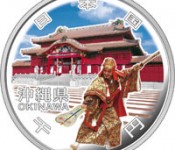
October 8, 2011 Ryukyu Shimpo
The Ministry of Finance has announced the designs of the 1000 and 500-yen coins for Okinawa prefecture as commemorative coins to mark the 60th anniversary of the enforcement of the Local Autonomy Act. Both coins will mark next year’s 40th anniversary of Okinawa’s reversion to Japanese administration. The 1000-yen coin has designs of Shuri Castle and kumiodori, while the 500-yen coin features the Naha Tug-of-War and eisa.
The prefecture requested submission of designs from last November to the end of year, and then a deliberation committee made selections to be submitted to the government. The designs represent the history, traditional culture and harmony among the people and communities of Okinawa.

500-yen coin featuring the Naha Ozunahiki or tug-of-war and an eisa parade (front)
The 1000-yen coin will have its color designs painted on silver. A total of 100000 of these coins will be issued and they will sell for 6000 yen each. Applications for purchase will be accepted from March 2012. The number to be issued of the 500-yen coin, which will be made from copper, cupronickel and nickel brass, is yet to be officially determined. The coins will begin to be redeemed in financial institutions from around July 2012.
(English Translation by T&CT, Lima Tokumori and Mark Ealey)
Go To Japanese
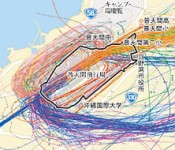
October 7, 2011 Ryukyu Shimpo
On October 6, the Okinawa Defense Bureau released the results of a survey conducted from January 1, 2010 until March 31, 2011 on the flight activities of rotary-wing craft based in the U.S. Marine Corps Futenma Air Station. Many helicopter flight activities went significantly beyond the traffic patterns reviewed and agreed upon in 2007 by the governments of Japan and the United States.” Nevertheless, the Bureau commented that this survey result “does not mean that they have not kept to the agreement.”
The survey did not indicate the specific number of flight activities observed straying off the routes set in the traffic pattern. All six people surveyed by the bureau for their view as experts are professional pilots or air traffic controllers of Japan Self-Defense Forces (JSDF).
Track charts are collated by months, with flight activities of off-trail traffic patterns observed. To a large extent, these flights were instances of going too far out of a traffic pattern over the airfield to the southwest from the north over places such as Futenma, Oyama, Mashiki and Ojana in Ginowan City, on circular flights around the base when landing or departing, but included flight in a straight line on the extended runway without going through the traffic pattern for helicopters.
With regard to wide-turn flights, the people responsible for the survey represented expert opinion by saying, “In emergency training with a certain traffic pattern, the helicopters might sometimes choose to land at the airport safely with a gentle turning angle. The Marine Corps must do some of its training in the context of assuming emergency situations,” therefore indicating that flight protrusion beyond agreed limits was unavoidable.
The flight path for the Futenma Air Station was agreed on by the governments of Japan and the United States in 2007 after a U.S. Marine helicopter crashed onto Okinawa International University. According to the traffic pattern agreed upon, wherever possible aircraft must fly around the runway to flying avoid over residential areas. This is the first time that the Okinawa Defense Bureau has investigated the flight situation around Futenma Air Station in earnest, and has published result of its survey. The Ministry of Defense requested that to the maximum extent possible U.S. military operate their aircraft within the traffic pattern, and received a response from the U.S. side to the effect that they agreed to strictly comply with this.
(English Translation by T&CT, Mark Ealey)
Go To Japanese

October 7, 2011 Fumiaki Jahana of Ryukyu Shimpo
On October 6, the telecommunications firm, InetJapan Co. Ltd. (Naha City, President Kunihiko Oroku) formed a capital alliance involving cross-shareholding with the Karasawa Solar (Taiwan) Corporation of Taiwan (President Shen Yen Shih), which has developed its own smartphone.
InetJapan plans to start domestic sales of the smartphone from around February 2012. The two companies are scheduled to hold a press conference at the Prefectural Office on October 11 at which they will display “Inetphone,” a smartphone developed by the Taiwan Karasawa Corporation, and explain details of its functions and user rates.
“Inetphone is a groundbreaking product with discount calling rates. I can confidently promote this product,” said Oroku enthusiastically.

In Naha City on October 6, Kunihiko Oroku (on the left), president of InetJapan, said that he is confident about the promotion and sales of Inetphone, a newly developed smartphone from Taiwan.
According to InetJapan, the Inetphone uses a newly developed battery, which can reduce electric power consumption in a way unlike any existing smartphone. The company said that the Inetphone is also equipped with a function by which it simultaneously interprets Japanese, Chinese and English (downloadable for free).
In conjunction with sales of the product, and aiming to promote Inetphone on a national level, InetJapan plans to establish a branch office in Tokyo. It plans to then go on to establish product distribution centers in major cities within and outside the country, and aims for sales worth 70 billion yen for the first year.
InetJapan began operating in 2006 and has been cooperating with the Karasawa Solar (Taiwan) Corporation by investing in the development of the Inetphone.
The Karasawa Solar (Taiwan) Corporation also began operating in 2006. A spokesperson for the company said that in addition to the development of this smartphone, it is engaged in making solar panels.
InetJapan formed a capital alliance with Karasawa Solar (Taiwan) in September in preparation for this announcement and obtained a telecommunication business license from the Ministry of Internal Affairs and Communications. It plans to promote the Inetphone throughout Japan.
Oroku said, “The Inetphone has the potential to take the world by storm. I think that it could help create jobs and stimulate the Okinawan economy. I would really like to have a good go at this business.”
(English Translation by T&CT, Mark Ealey)
Go To Japanese

October 6, 2011 Ryukyu Shimpo
The plaintiffs of the Futenma helicopter roar suit, led by Zenji Shimada, held a press conference in Ginowan City on October 5 in which they called for residents living around the air station to join them in preparing a second lawsuit next March to eliminate noise pollution. In this second lawsuit, they are aiming at about 2000 plaintiffs, which is 400 residents more than in the first suit. Shimada said, “We want as many local residents as possible to participate in our attempt to restore a quiet life to the neighborhoods around the base.”
The plaintiffs held meetings with residents at 16 locations around the air station with a total of 765 people participating. They began to accept participation in the action by the residents who live in areas located within the noise contours around the air station and which had a noise annoyance index of W75 or more in October. In addition to Ginowan City, some residential areas of Kitanakagusuku Village and Urasoe City are also included. Tsutomu Arakaki, chief of the legal team said, “The lawsuit seeking to stop flights has been dismissed on the grounds that the Japanese government has no authority to stop the flight activities of the United States aircraft or based on the theory that they have no authority over a third party. Through judicial proceedings and the residents’ movement we would like to change the judicial authorities’ perception of this matter.”
For further information contact the Office of the Plaintiffs of the Futenma helicopter roar suit. Telephone:098 (893) 5004.
(English Translation by T&CT, Mark Ealey)
Go To Japanese
October 5, 2011 Ryukyu Shimpo
In an essay published in the September/October 2011 issue of Foreign Affairs, an American magazine and website focusing on international relations and U.S. foreign policy, Senior Political Scientist Eric Heginbotham and Associate Political Scientist Ely Ratner of the RAND Corporation, a nonprofit global policy think tank with a close relationship with the U.S. Department of Defense, and a notable security analyst and director of the Center for International Studies at the Massachusetts Institute of Technology, Richard Samuels, pointed out that relocating the U.S. Marine Corp outside Okinawa would not have a significant impact in terms of the execution of operations in most emergency circumstances.
They wrote, “On the other hand, although the U.S. Marine Corps’ presence in the region is extremely important, its particular location in the western Pacific is less critical, as long as training facilities and infrastructure are adequate. Wherever they are based, the marines would deploy out of garrison for any conceivable mission.”
The essay denies “Okinawa’s geopolitical significance,” which was claimed by the Japanese government as the reason why it advocates the relocation of Futenma Air Station within the prefecture.
They continued, “The United States should continue working to relocate its marines off Okinawa to Guam (or elsewhere), as both sides agreed to do in 2006. This move would entail no significant loss of operational effectiveness in most contingencies, and it would be welcomed in Okinawa, reduce political pressure in Tokyo, and ultimately enhance the U.S.-Japanese alliance.”
The title of the essay is “Tokyo’s Transformation.”
Referring to Kadena Air Base’s effectiveness in deterring aggression by China and North Korea towards Taiwan and South Korea, the authors wrote, “The Kadena Air Base, for example, is particularly critical for deterrence against China and North Korea in Taiwan and South Korea. It also helps with a wide spectrum of other functions, including humanitarian assistance and disaster-relief operations, and provides some of the best access to parts of Southeast Asia.”
With regard to the Kadena-Futenma integration plan, which is proposed by U.S. Senators John McCain, Carl Levin, and Jim Webb, the authors claimed, “This proposal is refreshing and creative but problematic. The aircraft at Futenma are primarily transport helicopters designed to support the Marine Corps infantry on the ground in Okinawa; they contribute little to U.S. combat airpower. More important, if moved to Kadena, the U.S. Marine aircraft would occupy space needed for additional fighters, bombers, and combat support aircraft in the event of hostilities. Alternative solutions to the Futenma impasse should certainly be explored, but this should be done without compromising the Kadena Air Base’s unique benefits.”
(English Translation by T&CT, Mark Ealey)
Go To Japanese

October 5, 2011 Ryukyu Shimpo
For the first time in three decades, Ryukyuan traditional sweets called senjuko have been recreated and sold by the Chinsuko Hompo Arakaki Kashiten (a confectionery company) that has its head office in Shuri, Naha City. The thing that brought this about was Tempest, a novel set in the Ryukyu Dynasty. The company has been in business for 72 years, and can trace its know-how back to a chef in the Ryukyu Dynasty. The confectionary has been handcrafted from this February using traditional manufacturing methods.
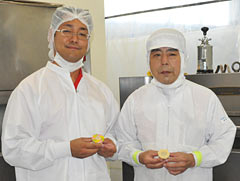
Satoshi Adaniya, factory director (right) and Yoshitoyo Arakaki, executive managing director of the company making senjuko, at the factory in Nanjo City.
The sweet bean paste used in
senjuko is made from peanut butter, sesame and
kippan, which is citrus peel boiled with sugar. This is then wrapped in a dough covering made using lard. As soon as you bite into it you can taste the flavor of peanuts and sesame, and from there the briskness of the citrus spreads through your mouth.
Executive managing director 36 year-old Yoshitoyo Arakaki explained, “Senjuko was prepared for Buddhist memorial services and celebrations, and was made often until around the reversion of Okinawa to Japanese sovereignty. However, the reversion meant that Japanese and Western confectionery prevailed, and traditional sweets with a complex manufacturing process disappeared.”
Factory manager 54 year-old Satoshi Adaniya, who has 37 years experience in this business behind him, learned the manufacturing method directly from the last chef, but he had a tough time remembering the details of the process. “Shaping the petals is difficult. I always ask myself am I doing it the right way, as I make them,” he said.
Senjuko is available only from four stores run by the company, and because it is made by hand, its production is limited to between 50 and 100 units a day.
During the Ryukyu Dynasty, Ryukyuan traditional sweets developed independently, with influence from both China and Japan. Although the names of over 200 sweets appear in literature, almost all of the recipes were lost with the overthrow of the dynasty and the awful damage to all manner of Okinawa’s cultural assets during World War II.
(English Translation by T&CT, Lima Tokumori and Mark Ealey)
Go To Japanese

October 5, 2011 Ryukyu Shimpo
Mark Ealey, a 54 year-old translator and researcher who resides in Christchurch, New Zealand, arrived in Okinawa on September 30 on the Japan Foundation’s Research Fellowship Program. He is translating the series of articles published under the title of Senka o Horu (Trans: Digging up the Ravages of War) in the Ryukyu Shimpo between August 1983 and April 1985. During his stay here until late December, he will continue the translation, conduct research in order to write supplementary explanation for English-speaking readers and research names of places and personal names etc. The English translation due to be published in the United States in book form, will be finished by the middle of 2012 and should be available by the end of next December.
Ealey and his colleague Alastair McLauchlan, Academic Program Leader at the Maori University, began the translation last August and have completed almost 90% of that part of the project. They will now start to prepare explanations of background topics and a detailed timeline of the Battle of Okinawa etc., and would also like to update facts that have come to light in the years since the articles were originally printed in the newspaper.
In an interview at the Ryukyu Shimpo office on October 3, Ealey said, “Our work is coming along well. Interest in the Pacific War is increasing in the United States, so when it is published, this book will definitely attract attention. We sincerely hope that more people becoming aware of the terrible realities of the Battle of Okinawa will contribute to maintaining peace in the world.”
(English Translation by T&CT, Mark Ealey)
Go To Japanese














 Webcam(Kokusai Street)
Webcam(Kokusai Street)


